Evolving Planet at the Field Museum (Part I)
 There is more to do at Chicago's Field Museum than one could properly do in a day. There's also more to write about than you'd find in one blog article. I've talked about the regular exhibits there, the Underground Adventure, and the Tut exhibit. Now I'm going to talk about something that I wish I spent more time in. It's pretty much the history of our planet. Like all history, it's in dispute. However, since I'm writing about this exhibit, I'm going to write about the views presented in it almost exclusively.
There is more to do at Chicago's Field Museum than one could properly do in a day. There's also more to write about than you'd find in one blog article. I've talked about the regular exhibits there, the Underground Adventure, and the Tut exhibit. Now I'm going to talk about something that I wish I spent more time in. It's pretty much the history of our planet. Like all history, it's in dispute. However, since I'm writing about this exhibit, I'm going to write about the views presented in it almost exclusively.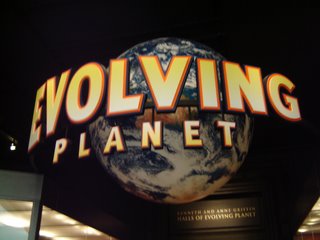 One of the more compelling arguments for the theology of naturalism (what I call the belief that there is no God and all that we are is the result of random occurrence, or the belief that God had no place in our development) comes in the form of the Field Museum's "Evolving Planet" exhibit. It shows how our home planet evolved over four billion years, from the emergence of single-celled organisms to the time of the dinosaurs, and finally human beings. It expands their already impressive dinosaur exhibit as well. It clearly uses dinosaurs, a very popular part of the museum, as an entree to promote the idea of evolution as scientists understand it today.
One of the more compelling arguments for the theology of naturalism (what I call the belief that there is no God and all that we are is the result of random occurrence, or the belief that God had no place in our development) comes in the form of the Field Museum's "Evolving Planet" exhibit. It shows how our home planet evolved over four billion years, from the emergence of single-celled organisms to the time of the dinosaurs, and finally human beings. It expands their already impressive dinosaur exhibit as well. It clearly uses dinosaurs, a very popular part of the museum, as an entree to promote the idea of evolution as scientists understand it today.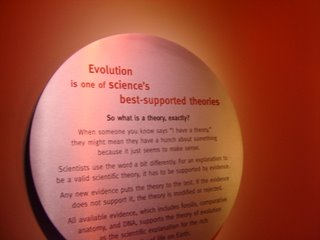 Right off the bat, there's a sign that explains what a theory is in scientific terms. You will see these signs in many science related museums, due to the fact that proponents of intelligent design (and other beliefs) are accused of using the phrase "it's only a theory" to discount evolutionary claims. Scientists are very sensitive about this.
Right off the bat, there's a sign that explains what a theory is in scientific terms. You will see these signs in many science related museums, due to the fact that proponents of intelligent design (and other beliefs) are accused of using the phrase "it's only a theory" to discount evolutionary claims. Scientists are very sensitive about this.Like any heated argument, the two sides are not really speaking to each other in an honest dialogue. Those promoting a philosophy stating that life developed randomly through natural selection alone attempt to paint proponents of Intelligent Design as "creationists," which is an entirely different viewpoint of how we got here. That view is based on a literal interpretation of the creation story in the first book of the Jewish and Christian Bible. People who believe this are rarely in the discussion because no one pays attention to them.
Unfortunately, in the May 2006 issue of Discover magazine, the Field Museum CEO John McCarter engages in this practice. He is quoted there saying:
"I think that five years from now, creationism as a theology will still be powerful, but this intelligent design tactic, which is supported by a very small group of people, will be history."To be fair, McCarter does put science in its proper context, even though it appears many scientists do not:
"Where we get in trouble as a society is when people of one persuasion or one capability jump into another field -- when theologians come into science and attempt to reinterpret scientific records through supernatural intervention, and alternatively, when scientist go into theology and say 'There is no God." It is really not the business of either. There should be a common dialogue, a middle ground where people can discuss issues like this as matters of philosophy as well as matters of theology and matters of science."Unfortunately, it's clear that his museum is not that kind of place. I'm not sure where that place is.
The Intelligent Design folks seem to want to paint the natural selection folks as lacking objectivity, and some of them feel that there is a conspiracy against their ideas. They want their ideas presented on equal terms in schools and in other places. It's a long story as to why that's not likely to happen, and some of it includes scientific consensus, the definition of science, politics and that God has a habit of being hard to define in numbers.
My thought on this before I go on to the fun stuff of talking about an exhibit? I cannot argue with facts. If one animal in one time is related to the other, and our best evidence supports it, I see no reason to doubt that based on my beliefs, which are decidedly Christian. If natural selection is right, and at the moment we just don't have enough evidence to definitively say it is, then it is the structure God put forth to make us today.
However, my Christian beliefs do not force me to believe that natural selection is implausible. In other words, I see no conflict between science and faith. They are two sides of the same coin: they are ways in which we as humans seek to find the truth of our world, universe, and existence. It's why I've always lumped the two together in my blog. If fossils are similar to each other and DNA matches up, or whatever evidence is presented, or whatever facts proven, then they should not be ignored.
There will be blanks to fill in, and honest, intelligent people may fill those blanks differently. When we do, however, we should do our best not to demagogue the other.
Now that I've got that out of the way, check this fantastic exhibit out...
 The presentation is divided into eras like this one, four billion years ago. Right off the bat, we learn that the building blocks of life may have come from extraterrestrial sources 500 million years ago. Scientists who have studied specimens of this type have found organic material on them.
The presentation is divided into eras like this one, four billion years ago. Right off the bat, we learn that the building blocks of life may have come from extraterrestrial sources 500 million years ago. Scientists who have studied specimens of this type have found organic material on them.So there you go, we're all descendents of immigrants.
Conversely, organic compounds may have formed on Earth, a sign says, perhaps in hydrothermal vents deep on the ocean floor.
I hate to say it, but it's just a theory. This rock is an example of a rock with hydrothermal vents. Consider it our first studio apartment.
 3.5 billion years ago, tiny single-celled organisms are believed to have been living in the Earth's oceans. The process of photosynthesis, a chemical reaction that turns carbon dioxide and water into sugars for food, may have come into play at this point. It's waste product, oxygen, would eventually become important to us.
3.5 billion years ago, tiny single-celled organisms are believed to have been living in the Earth's oceans. The process of photosynthesis, a chemical reaction that turns carbon dioxide and water into sugars for food, may have come into play at this point. It's waste product, oxygen, would eventually become important to us. Two billion years ago, photosynthetic bacteria called cyanobacteria released oxygen into the oceans and atmosphere, allowing us to eventually waste a lot of hot air arguing about this stuff. These rocks, called stromatolites, show a record of this process.
Two billion years ago, photosynthetic bacteria called cyanobacteria released oxygen into the oceans and atmosphere, allowing us to eventually waste a lot of hot air arguing about this stuff. These rocks, called stromatolites, show a record of this process.Scientists believe that 2.5 billion years ago, eukaryotes, or us (life that is not single celled) would develop from single celled life.
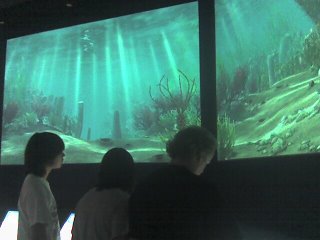 Everything that is alive today may be traced back to the Cambrian Period (533 to 490 million years ago). Did you notice that I just skipped a lot of time? Like billions of years? This is why we have conflicts over issues related to life on Earth.
Everything that is alive today may be traced back to the Cambrian Period (533 to 490 million years ago). Did you notice that I just skipped a lot of time? Like billions of years? This is why we have conflicts over issues related to life on Earth. Trilobites, like this one from the Czech Republic dated 543-490 million years ago, are one of the more common type fossils found from this period. Most, if not all, life was confined to water.
Trilobites, like this one from the Czech Republic dated 543-490 million years ago, are one of the more common type fossils found from this period. Most, if not all, life was confined to water. Time periods in the exhibit are divided into time periods of mass extinctions.
Time periods in the exhibit are divided into time periods of mass extinctions. This early land plant, defined as Chaleuria Cirrosa from the Devonian Period is dated 417-354 million years ago. The world has a lot of small plants at this time period and what's called the Silurian Period (443-417 million years ago). At this time, plants and animals began moving on land.
This early land plant, defined as Chaleuria Cirrosa from the Devonian Period is dated 417-354 million years ago. The world has a lot of small plants at this time period and what's called the Silurian Period (443-417 million years ago). At this time, plants and animals began moving on land. Fish began to develop into a recognizable form. This Jawless Fish (ostracoderm) was found in the Devonian period, but did not survive the end of it. Examples of these fish were found in Wyoming and the Netherlands.
Fish began to develop into a recognizable form. This Jawless Fish (ostracoderm) was found in the Devonian period, but did not survive the end of it. Examples of these fish were found in Wyoming and the Netherlands.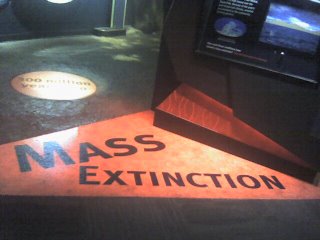 But they all died.
But they all died.The Carboniferous Period (354-290 million years ago) began. Swampy tropical forests developed in Europe, Asia, and North America, which were gathered at the equator (yes, continents move, but that's another story).
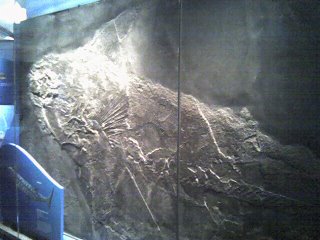 Life that wasn't all just little cute and cuddly developed. This shark, or chondrichthyan fish lived in Indiana sometime between 354-290 million years ago (although it wasn't Indiana then, because continents move).
Life that wasn't all just little cute and cuddly developed. This shark, or chondrichthyan fish lived in Indiana sometime between 354-290 million years ago (although it wasn't Indiana then, because continents move). The Permian Period (290-248 million years ago) followed it, and the continents that were swimming around began to form one giant supercontinent: Pangaea.
The Permian Period (290-248 million years ago) followed it, and the continents that were swimming around began to form one giant supercontinent: Pangaea.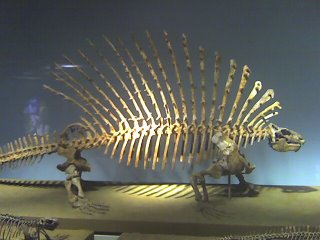 In this environment, tetrapods, or four-limbed vertebrates, began to come into the forefront. The Edaphosaurus were an example of these new beings. It is one of the earliest known plant eating animals.
In this environment, tetrapods, or four-limbed vertebrates, began to come into the forefront. The Edaphosaurus were an example of these new beings. It is one of the earliest known plant eating animals. But they died. In fact, the end of the Permian Period was also the end of the Paleozoic Era (543 to 248 years ago). This was a real "end of an era," as it is recognized as the largest mass extinction recorded in the history of life on Earth. Scientists are not sure why it happened, although some have a theory (their use, not mine) that volcanic activity led to drastic global warming and the death of many animals. I'll bet though that most scientists will not say that "God did it" and leave it at that.
But they died. In fact, the end of the Permian Period was also the end of the Paleozoic Era (543 to 248 years ago). This was a real "end of an era," as it is recognized as the largest mass extinction recorded in the history of life on Earth. Scientists are not sure why it happened, although some have a theory (their use, not mine) that volcanic activity led to drastic global warming and the death of many animals. I'll bet though that most scientists will not say that "God did it" and leave it at that.Well get into those new creatures in my net post though.
RELATED LINKS:
Why Science Conflicts With Religion



0 Comments:
Post a Comment
|<< Home